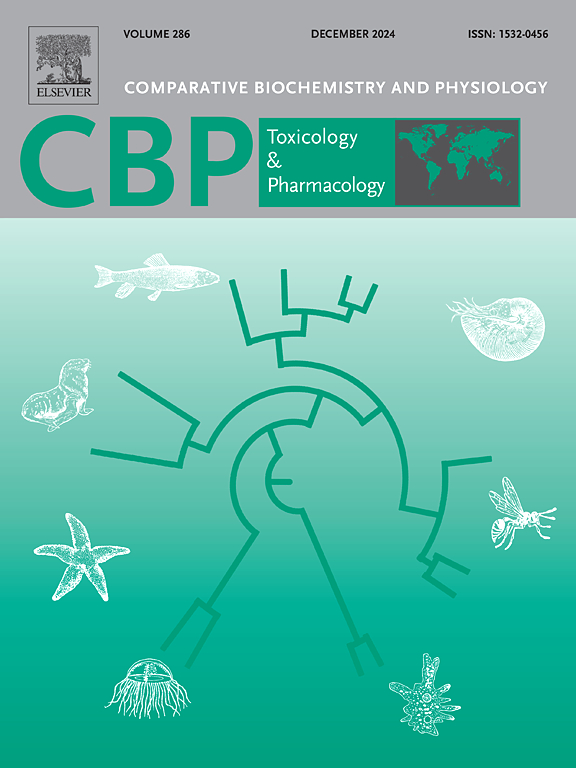金属-有机骨架HKUST-1及其碳化产物对斜四角鼠的毒性机制:生理和转录组学分析。
IF 3.9
3区 环境科学与生态学
Q2 BIOCHEMISTRY & MOLECULAR BIOLOGY
Comparative Biochemistry and Physiology C-toxicology & Pharmacology
Pub Date : 2025-01-21
DOI:10.1016/j.cbpc.2025.110130
引用次数: 0
摘要
金属有机骨架(MOFs)是一种具有独特结构和性能的新兴材料,由于其各种优点,在许多领域得到了广泛的应用。然而,与其广泛的应用研究相比,mof的生态安全性却鲜有报道。本文以普通淡水绿藻Tetradesmus obliquus (T. obliquus)为生物学模型,研究了铜基MOF hust -1及其碳化产物DHKUST-1对藻类生理和转录水平的影响。一套先进的材料表征技术被用于多维度地揭示HKUST-1及其碳化产物的物理化学性质。值得注意的是,DHKUST-1在水环境中表现出比HKUST-1更高的稳定性,离子释放更低。在96 h的暴露试验中,测定藻类密度、叶绿素-a含量和抗氧化酶活性等相关指标。此外,我们还建立了一个有趣的IBR模型来综合评估HKUST-1和DHKUST-1对斜斜体抗氧化系统的毒性。进一步深入分析10 mg/L HKUST-1胁迫下斜斜t的差异基因表达变化,探讨其对藻类细胞内各途径的影响。简而言之,HKUST-1对斜棘球绦虫的毒性机制是多方面的。本研究结果有望为MOFs生态安全评价提供重要的基础数据和参考。本文章由计算机程序翻译,如有差异,请以英文原文为准。

Toxicity mechanism of metal-organic framework HKUST-1 and its carbonized product to Tetradesmus obliquus: Physiological and transcriptomic analysis
Metal-organic frameworks (MOFs) are emerging materials with unique structures and properties, which have been widely used in many fields due to their various advantages. However, compared with its popular application research, the ecological safety of MOFs has rarely been reported. In this paper, a biological model, the common freshwater green algae Tetradesmus obliquus (T. obliquus) was used to study the effects of the copper-based MOF HKUST-1 and its carbonation product DHKUST-1 on the physiology and transcription level of the algae. A suite of advanced material characterization techniques has been utilized to multidimensionally reveal the physicochemical properties of HKUST-1 and its carbonation product. Notably, DHKUST-1 exhibit higher stability than HKUST-1 in aqueous environments, with lower ion release. During a 96-h exposure experiment, relevant indicators such as algae density, chlorophyll-a content and antioxidant enzyme activities were measured. Additionally, an intriguing IBR model was employed to comprehensively assess the toxicity of HKUST-1 and DHKUST-1 on the antioxidant system of T. obliquus. Furthermore, an in-depth analysis was conducted on the differential gene expression changes in T. obliquus under 10 mg/L HKUST-1 stress, exploring the impact on various pathways within algal cells. Briefly, the toxicity mechanism of HKUST-1 on T. obliquus is multi-involved. The findings of this study are expected to provide important basic data and references for the evaluation of the ecological safety of MOFs.
求助全文
通过发布文献求助,成功后即可免费获取论文全文。
去求助
来源期刊
CiteScore
7.50
自引率
5.10%
发文量
206
审稿时长
30 days
期刊介绍:
Part C: Toxicology and Pharmacology. This journal is concerned with chemical and drug action at different levels of organization, biotransformation of xenobiotics, mechanisms of toxicity, including reactive oxygen species and carcinogenesis, endocrine disruptors, natural products chemistry, and signal transduction with a molecular approach to these fields.

 求助内容:
求助内容: 应助结果提醒方式:
应助结果提醒方式:


